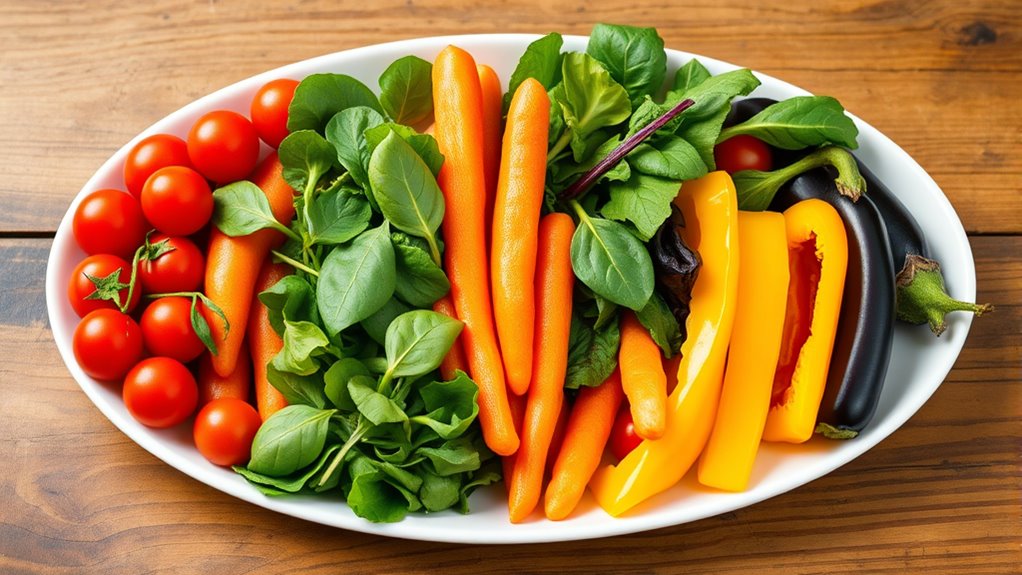Colorful plates tap into your visual senses, making meals more appealing and stimulating your appetite in a balanced way. Warm colors like reds and oranges encourage you to enjoy your food, while cool shades like blues and greens promote calmness and help prevent overeating. The vibrant variety creates a visual feast that signals nourishment without sensory overload, making you more mindful of portion sizes. Keep exploring, and you’ll discover how these visual cues can support healthier eating habits.
Key Takeaways
- Colorful plates enhance visual appeal, making meals more satisfying and reducing the tendency to overeat.
- Bright, varied colors stimulate appetite control through visual cues, encouraging mindful portioning.
- Rainbow meals evoke positive emotions, decreasing stress-related eating and promoting healthier choices.
- Visual diversity signals nourishment, helping individuals recognize fullness cues sooner.
- The aesthetic of colorful plates fosters a more enjoyable eating experience, supporting sustainable healthy habits.

Colorful plates do more than just look appealing; they influence how you perceive and enjoy your meals. When you see a vibrant array of colors on your plate, your brain processes these hues through a process called color perception. This process isn’t just about aesthetics—it’s about how your mind interprets the visual cues, which can directly impact your appetite and eating behavior. Bright, varied colors provide visual stimulation that engages your senses on a deeper level. The more visually stimulating your plate is, the more your brain is encouraged to associate eating with pleasure and satisfaction, often leading to better portion control and reduced overeating.
The psychology behind colorful plates shows that the way colors influence your mood and perception can be powerful. For instance, warm colors like reds and oranges tend to stimulate appetite, making meals feel more inviting. Conversely, cooler shades such as blues and greens are often associated with calmness and can suppress hunger. When you intentionally include a spectrum of colors—think of a salad with red tomatoes, orange carrots, green spinach, and purple cabbage—you create a visual feast that signals nourishment without overwhelming your senses. This balance helps you enjoy your meal more fully while preventing the tendency to eat mindlessly or excessively.
Your visual stimulation plays a vital role in how you experience food. When a plate is colorful and well-arranged, it grabs your attention and enhances your overall perception of the meal’s appeal. This heightened visual engagement triggers positive feelings, making the food seem more flavorful and satisfying, which can lead to a quicker sense of fullness. Because you’re more satisfied with less food, colorful plates can be an effective tool in curbing overeating. They help shift your focus from quantity to quality, encouraging you to savor each bite and recognize fullness cues sooner.
Moreover, the strategic use of color can influence your emotional state, which indirectly affects your eating habits. Bright, cheerful colors boost your mood and can reduce stress-related eating. When you feel good about what’s on your plate, you’re less likely to seek comfort in overeating. The combination of visual stimulation and positive emotional response creates a mindful eating experience—one where you’re more aware of your hunger and fullness levels. A further benefit is that HEPA filters in modern air purifiers can help reduce airborne irritants and allergens that might otherwise contribute to discomfort or respiratory issues, supporting overall health as you develop healthier eating habits. Over time, this awareness helps establish healthier eating patterns, making colorful plates not just visually pleasing but also a practical approach to managing portion sizes and preventing unnecessary calorie intake.
Frequently Asked Questions
How Do Different Cultures Perceive Colorful Versus Plain Foods?
You might notice that different cultures perceive colorful foods through their unique cultural food symbolism and traditional meal aesthetics. In some traditions, vibrant dishes symbolize prosperity and celebration, making colorful plates more appealing. Others prefer simpler, plain foods for their elegance or practicality. Your appreciation for colorful versus plain foods is shaped by these cultural influences, which influence how you view the visual appeal and significance of a meal.
Can Color Psychology Influence Long-Term Eating Habits?
Did you know 70% of food choice motivations are driven by emotional responses to color? Color psychology can influence your long-term eating habits by shaping how you perceive and respond to food. Bright, colorful meals often evoke positive feelings, encouraging mindful eating and reducing overeating. Over time, these emotional responses to color can reinforce healthier habits, making it easier to maintain a balanced diet and enjoy food without guilt.
Are There Specific Colors That Are More Effective in Reducing Overeating?
You might find that certain colors, like blue and green, are more effective in reducing overeating because they enhance plate aesthetics and evoke calming feelings through color symbolism. These colors help you feel satisfied with smaller portions, making it easier to control your intake. By choosing plates with these hues, you can subtly influence your eating habits, encouraging healthier choices through visual cues and emotional responses.
How Does the Presentation of a Plate Impact Meal Satisfaction?
You notice that plate aesthetics and visual appeal greatly influence your meal satisfaction. When your plate looks colorful and well-arranged, it enhances your perception of the meal’s quality and taste. A thoughtfully presented plate makes your food more appetizing, encouraging you to enjoy each bite more fully. This visual engagement can also help you eat mindfully, preventing overeating and boosting your overall satisfaction with your meal.
What Role Does Individual Personality Play in Response to Colorful Foods?
Your personality traits influence how you respond to colorful foods. If you’re more open and adventurous, vibrant meals excite you and boost your emotional responses, making you feel more satisfied and less likely to overeat. Conversely, if you’re more cautious or less receptive to new experiences, colorful foods might not appeal as much. Your unique personality shapes your emotional reactions, impacting your overall enjoyment and portion control when it comes to rainbow meals.
Conclusion
By choosing colorful plates, you’re not just adding vibrancy to your meals—you’re tricking your mind into feeling satisfied with less. When you fill your plate with a rainbow of foods, it’s like painting a masterpiece that keeps overeating at bay. Remember, a picture is worth a thousand words, and a colorful plate can speak volumes about your self-control. So, embrace the spectrum and turn your mealtime into a feast for both eyes and waistline.









